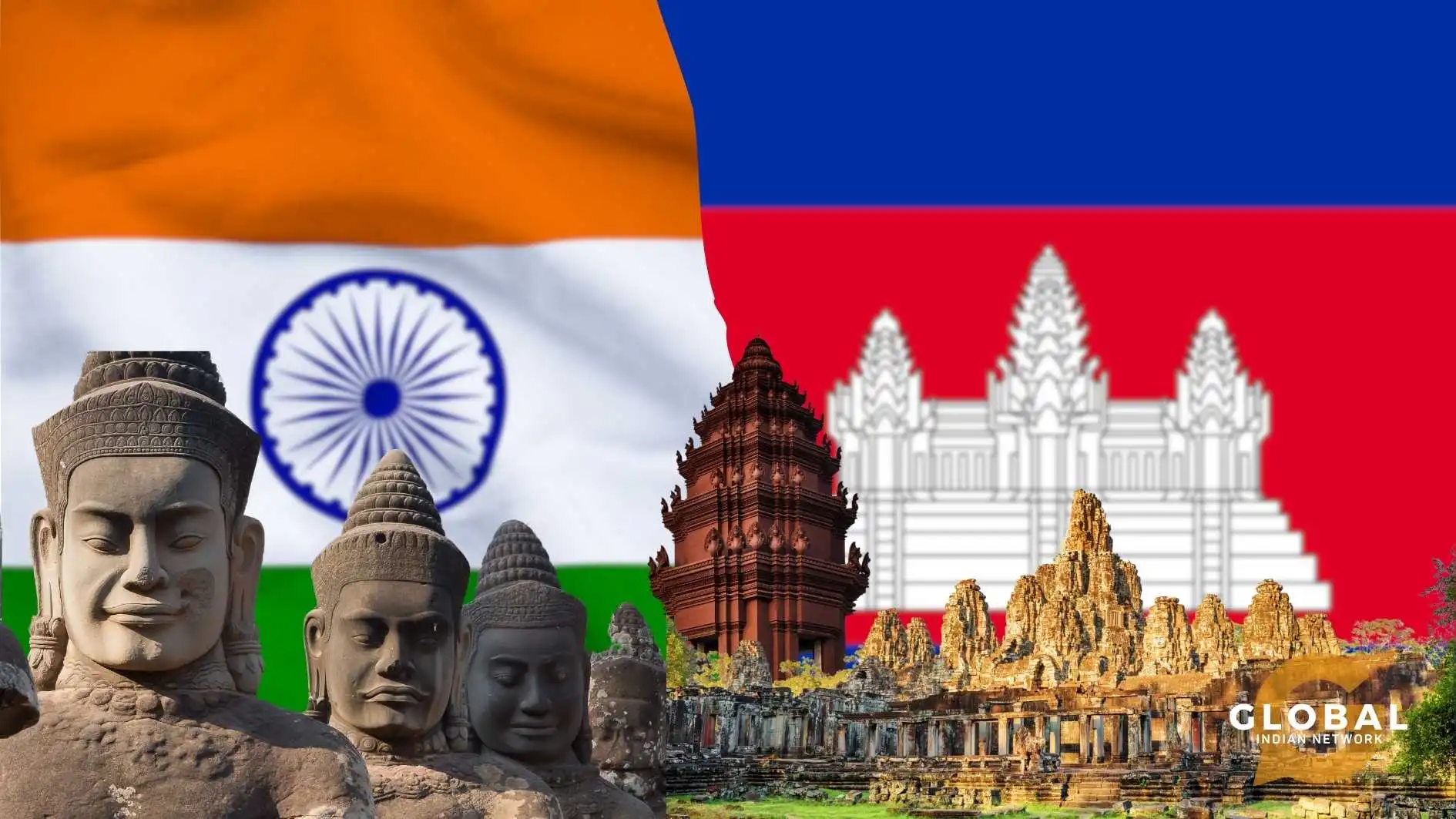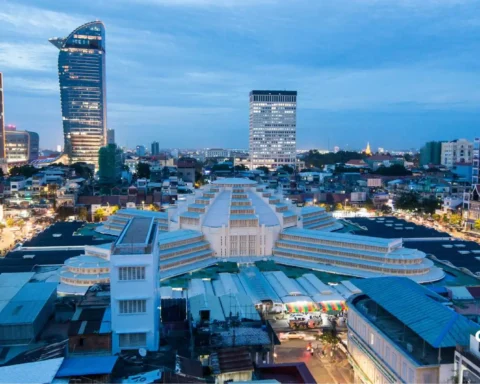The historical connection between India and Cambodia traces back to ancient times; although far from each other geographically, they have had an ancient and historical connection for over 1,000 years. This relationship showed us cultural exchange, trade, religion, art, and architecture between the two countries, which crossed seas and influenced civilizations. India’s cultural evidence found in Cambodia can be seen in its literature, religion, and architecture. This continues to shape Cambodian identity even today.
The development of the Khmer script and the world-renowned temple Angkor Wat show a historical and cultural connection between India and Cambodia. From the ancient trade routes to the spread of Hinduism and Buddhism, explore the remarkable relationship between India and Cambodia.
The presence of Indian culture in Cambodian life is also because of the fact that many Buddhist scholars crossed seas and dangerous lands and settled in the East. Their teachings and culture became a part of a Cambodian’s life. There are many Sikhs and Sindhis who went to Cambodia for trade and earned the respect and trust of the people there. The Indians living there have become a living connection between India and Cambodia, which strengthens the relationship between these two nations.
Table of Contents
Historical Connection Between India and Cambodia: Religious and Cultural Influence
The most remarkable impact India had on Cambodia was the influence and the peaceful spread of religion and culture in Cambodia. Cambodia is the homeland of the Khmer people, who now follow Theravada Buddhism. Today, approximately 90% of people in Cambodia follow Buddhism, and there are many striking similarities in culture and tradition with those of Hinduism.
The earlier kings followed Brahmanism, which is proved by the sculptures and relics found in the temples of Siem Reap. Buddhism mostly came into power in the 12th century when King Jayaverman VII, who also followed Buddhism, came into power and declared his state a Buddhist state. He was considered one of the greatest kings of the Khmer Empire. Even though there were two religions in this nation, they coexisted in harmony.
The Spread of Religion and Culture
Locals believe in a legend that the country talks about, which is the marriage between the Indian prince Kaundinya and the Cambodian princess Soma. This legend is popular among locals as it traces the connection between the Indo-Khmer culture and civilization. The Indo-Khmer cultural connection was flourishing. The predominance and culture spread easily because it came very naturally without any political dominance and became a powerful driving force for the nation’s cultural development and its similarities within philosophy, religion, ideology, etc.
The indigenous people of Cambodia, known as the Khmer, believed in animism, referred to as ‘neak ta’, and Hinduism, particularly Brahminism, also practised a similar form of animism. This brought in religious and cultural fusion among the people. We see a gradual emergence of Hinduism and Buddhism, and the Indian culture found its way into Cambodia. The animistic foundation and Indian philosophical and spiritual contributions created harmony between the locals who believed in animism; for this reason, the locals and the elites accepted Indian culture.
The ‘krong peali’ is a house-warming ritual done before every ritual, such that the ritual goes peacefully and smoothly, which is known as the bhumi pujan ritual in India. This ritual is mostly related to Hinduism, but is practiced by Buddhists as well in a Buddhist way. Although Buddhism believes in karma and does not believe in the blessing of deities or the concept of a ‘good day’, it is very hard to separate Brahmanical beliefs from Buddhism, as they coexisted for so long.
However, the historical connection between India and Cambodia traces back to history when, in the 5th century, Mahayana Buddhism was practiced, but today Theravada Buddhism is practiced predominantly and is the official religion of the country. The earliest form of Buddhism and some Hindu influences came into the kingdom of Funan with the Hindu merchants. During the Angkor Empire, Cambodia accepted various Buddhist traditions of the Mon kingdom of Dvaravati and Haripunchai. For thousands of years in Khmer history, Cambodia was ruled by a series of Hindu kings and some Buddhist kings, such as Jayavarman VII. Buddhism and Hinduism coexisted peacefully, assimilating culture and traditions.

Historical Connection Between India and Cambodia: In the Forms of Art and Architecture
The historical connection between India and Cambodia can also be traced back in terms of art and architecture. The spread of Indian culture, especially Hinduism and Buddhism, through travellers and merchants, as well as migration, brought in religious texts, iconography, and architectural techniques to Cambodia. The Khmer temples are closely associated with Indian concepts. The technique of Indian rock-cut architecture, which is present in Ellora and Ajanta, became a prime example for Khmer builders.
The Khmer architecture is influenced by the concept of Mount Meru, which is a mythological mountain at the center of the universe in Hindu and Buddhist cosmology. Indian temples were built in such a form that the central tower represented Mount Meru, and the surrounding towers represented its ranges. This concept of Mount Meru was adopted by Khmer architects, who built temples as a symbolic representation of Mount Meru.
The use of stone was seen in Khmer temples, where they modified Indian architectural elements such as the shikara and created their style and form to build. The use of sandstone and laterite contributed to the durability of the temples. The mandala-like layout, which was used in Indian architecture, was also adopted by the Khmer builders. The mandala is an essential part of Hindu and Buddhist architecture because it was used as a symbolic map of the cosmos in both Indian and Khmer structures.
Iconography
Indian rock-cut architecture was a key aspect of the Khmer approach to temple construction. The intricate carving of the relics and sculptures shows similarities between Indian rock-cut architecture. The reliefs in Angkor Wat depict Hindu epics, such as the Ramayana and Mahabharata, as well as Buddhist iconography. The precise carvings of the devatas and apsaras can be traced back to the Indian influence in iconography in its architecture. The Khmer blended Indian iconography with their local artistic touches. The carving of local deities in temples is a prime example of how Indian religions integrated with Khmer culture and beliefs.
The Angkor Wat
Angkor Wat was built by the Khmer king Suryavarman II in the early 12th century. It was recognized by UNESCO as a World Heritage site in 1992. The Angkor Wat is decorated with depictions of apsaras and devatas, which have more than 1796 depictions of devatas in the research inventory. The depiction of Hindu epics, such as the Ramayana and Mahabharata, can be seen in the inner walls of the outer gallery. The scene in the southern gallery depicts the churning of the sea of milk, showing 92 asuras and 88 devas.
Historical Connection Between India and Cambodia: Language and Literature
The linguistic connection between India and Cambodia, as seen in the Cambodian language, Khmer, has been significantly influenced by Sanskrit, a classical and ancient language of India. There are many Khmer words, especially those related to governance, literature, and religion, that are derived from Sanskrit.
The introduction of Sanskrit literature in Cambodia flourished local literature that had Indian themes and narratives. The Khmer script was developed from the Pallava script, which originated from South India. The Pallava script helped facilitate Khmer documentation, literature, religious texts, and historical records.
The Angkor period marked the adaptation of Indian epics and stories. The translation of the Ramayana and Mahabharata into Khmer played a crucial role in cultural expression and cultural identity. The historical connection between India and Cambodia can be traced back to the Indian literary traditions. These epics provided a framework for moral education and societal values. The use of Sanskrit in the religious ceremonies of Cambodia shows a deep connection between these two nations.
Conclusion
The historical connection between India and Cambodia is remarkable because of how civilizations came together, blended cultures, and coexisted peacefully. The religious transmission of Hinduism and Buddhism brought in Indian culture, traditions, art, architecture, and religious ideas, showing inclusivity and the bond between Indian culture and Cambodian culture. The strong influence of Hindu and Buddhist rituals and mythology has its own contributions in shaping Cambodia’s cultural heritage.
The concept of Mount Meru and mandalas brought in a philosophical approach to the building of the Khmer temples, showing how Indian architecture and philosophy influenced its making. We need to know that these two civilizations never fought; they peacefully flourished together, it was never a result of colonization, and they both were mutually influential without any political strings attached.

FAQs
Where is Angkor Wat located?
Angkor Wat is located in northern Cambodia, specifically near the city of Siem Reap.
Which is the primary religion in Cambodia?
The primary religion in Cambodia is Theravada Buddhism, which is also the state religion.
Which is the capital city of Cambodia?
Phnom Penh is the capital and largest city of Cambodia.









